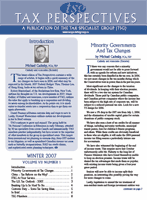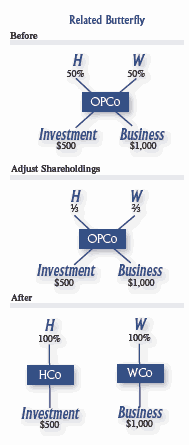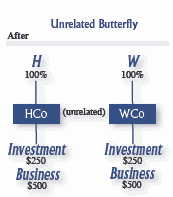
PDF Format
 Issue Contents Issue Contents
 All Issues All Issues
Winter 2007
Volume 7, Number 1
The information in Tax Perspectives is prepared for general interest only. Every effort has been made to ensure that the contents are accurate. However, professional advice should always be obtained before acting and TSG member firms cannot assume any liability for persons who act on the basis of information contained herein without professional advice.
Breaking Up Is So Hard To Do
By Manu Kakkar, CA, CGA, TEP
Manu Kakkar CA Inc. (London, Ontario; Montreal, Quebec)
The biggest complaint I hear from clients (as well as my family!) about income tax is that it does not make any sense. In the client's view, a fairly straightforward business concept becomes convoluted by income tax laws created by divergent tax policy objectives. However, one area of income tax practice where the policy objectives are in line with societal norms is divisive reorganizations, or, in plain English, corporate divorce.
When people get married, events leading up to the wedding day seem to be a blur and everything is going at a mile a minute. However, when the same people get a divorce, the process may very well be slow, grinding and in some cases, an amicable resolution is just unworkable.
It is usually easy to transfer assets into a corporation. However, when one or more businesses or a particular group of assets within a corporation are to be transferred out, the complications begin.
The reason why a divisive (or break-up) reorganization is complicated is simple: there is a direct rollover to transfer an asset into a taxable Canadian corporation. There is no direct rollover, however, to transfer the same asset out of the same corporation back to the shareholder. As a result, the "corporate break-up" must rely on a complicated series of steps to transfer the asset from one corporation to another without tax.
One key provision that the divisive reorganization relies on is the tax-free inter-corporate dividend. However, where the corporation receives a dividend in the context of a divisive reorganization, it may be deemed a capital gain. If so, the reorganization will not be tax-free.
Two Kinds of Butterfly
Tax practitioners often refer to a divisive reorganization as a "butterfly." The reason for this nickname is because the corporate chart of the steps looks like the wing (or wings- depending on the complexity of the reorganization) of a butterfly. There are two kinds of butterflies: a related party butterfly and an unrelated party butterfly. A related party butterfly, simply put, involves a divestiture of assets within a related group of persons. It is prudent to mention that siblings and by extension, corporations owned by siblings, are deemed to be unrelated for the butterfly rules.
The final result of any butterfly transaction is to put the assets into corporations owned by each shareholder.
A related party butterfly is easier to implement than its unrelated party counterpart. The reason is that the unrelated party butterfly has severe restrictions on the transactions that can be done prior to, during, and after the reorganization.
The most important of these restrictions is the "pro-rata test." In an unrelated party butterfly, each shareholder corporation must receive a proportionate share of each type of asset of the corporation, i.e., cash and near cash; business assets; and investment assets. The determination of where a particular asset falls in the classification system is not always clear. of where a particular asset falls in the classification system is not always clear.
The inability to comply with the pro-rata test is the biggest reason why the unrelated party butterfly cannot be done. The related party butterfly does not have to comply with the pro-rata test.
Related Butterfly Example
Husband (H) and wife (W) each own 50% of the common shares of a corporation, Opco. Opco owns a business worth $1,000 and an investment portfolio worth $500. W runs the business and H manages the investments. H and W wish to divorce and as part of this, to divide and separate Opco's assets.
To achieve the desired result, W would first buy 16?% of Opco from H, bringing her ownership to 66?%. This is so the assets can be divided according to fair market value.
After the reorganization, H and W each have their own separate corporations, HCo and WCo, with the investments ($500) and business ($1,000), respectively.
Unrelated Butterfly
Now, suppose H and W were divorced at the time of the reorganization or were unrelated parties, or brother and sister. Then an unrelated party butterfly would have to be undertaken. This would require that HCo and WCo each receive $500 of the business assets and $250 of the investments. These amounts represent each of H's and W's pro-rata share of the underlying corporate assets.
This corporate split-up might be unacceptable because W wants all of the business assets and H wants all of the investments. Unfortunately, it is not acceptable to rearrange the shareholdings before or after the butterfly (as was done above when W bought 16?% of Opco from H.) Lastly, this type of butterfly cannot be carried out to facilitate an arm's length sale.  For example, if W's motivation for the butterfly was to sell the business, the butterfly would not work. For example, if W's motivation for the butterfly was to sell the business, the butterfly would not work.
Unrelated Butterfly
Still, there are many instances where an unrelated party butterfly will work, especially in separating real estate assets.
Conclusion
The related and unrelated party butterflies are powerful tools in corporate restructuring and divestitures as well as estate planning. The tax authorities closely monitor these rules with an unusual combination of legislation and administrative practice. A skilled tax advisor needs to be consulted in order to navigate the many pitfalls of this area.
|






 of where a particular asset falls in the classification system is not always clear.
of where a particular asset falls in the classification system is not always clear. For example, if W's motivation for the butterfly was to sell the business, the butterfly would not work.
For example, if W's motivation for the butterfly was to sell the business, the butterfly would not work.